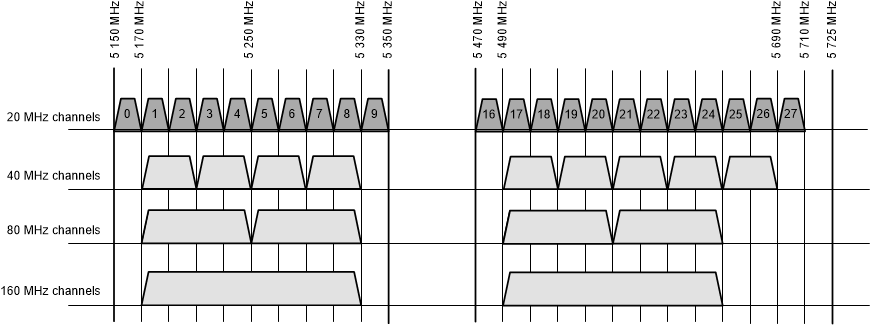SWRA670A April 2020 – October 2022 CC1350 , CC1352P , CC1352R , CC2400 , CC2420 , CC2430 , CC2500 , CC2520 , CC2530 , CC2538 , CC2540 , CC2541 , CC2543 , CC2544 , CC2545 , CC2564 , CC2590 , CC2591 , CC2592 , CC2620 , CC2630 , CC2640 , CC2650 , CC2652P , CC2652R , CC2652R7 , CC2652RSIP , CC3100 , CC3120 , CC3135 , CC3135MOD , CC3200 , CC3200MOD , CC3220MOD , CC3220MODA , CC3220R , CC3220S , CC3220SF , CC3230S , CC3230SF , CC3235MODAS , CC3235MODASF , CC3235MODS , CC3235MODSF , CC3235S , CC3235SF , WL1801MOD , WL1805MOD , WL1807MOD , WL1831
- CE Regulations for SRDs Operating in License-Free 2.4 GHz/5 GHz Bands
- Trademarks
- 1 Introduction
- 2 Regulation Overview
- 3 Radio Equipment Directive (RED)
- 4 ETSI EN 300 440
-
5 ETSI EN 300 328
- 5.1 Technical Requirements
- 5.2 Equipment Types
- 5.3
Conformance Requirements
- 5.3.1
Conformance Requirements for Frequency Hopping Equipment
- 5.3.1.1 RF Output Power
- 5.3.1.2 Duty Cycle
- 5.3.1.3 Accumulated Transit Time, Frequency Occupation and Hopping Sequence
- 5.3.1.4 Hopping Frequency Separation
- 5.3.1.5 Medium Utilization (MU) Factor
- 5.3.1.6 Adaptivity (Adaptive FHSS)
- 5.3.1.7 Occupied Channel Bandwidth
- 5.3.1.8 Transmitter Unwanted Emissions in the Out-of-Band Domain
- 5.3.1.9 Transmitter Unwanted Emissions in the Spurious Domain
- 5.3.1.10 Receiver Spurious Emissions
- 5.3.1.11 Receiver Blocking
- 5.3.1.12 Geo-Location Capability
- 5.3.2
Conformance Requirements for Wideband Data Transmission Equipment (Non-FHSS)
- 5.3.2.1 RF Output Power
- 5.3.2.2 Power Spectral Density
- 5.3.2.3 Duty Cycle, Tx-sequence and Tx-gap
- 5.3.2.4 Medium Utilization Factor
- 5.3.2.5 Adaptivity (Non-FHSS)
- 5.3.2.6 Occupied Channel Bandwidth
- 5.3.2.7 Transmitter Unwanted Emissions in the Out-of-Band Domain
- 5.3.2.8 74
- 5.3.2.9 Transmitter Unwanted Emissions in the Spurious Domain
- 5.3.2.10 Receiver Spurious Emissions
- 5.3.2.11 Receiving Blocking
- 5.3.2.12 Geo-Location Capability
- 5.3.1
Conformance Requirements for Frequency Hopping Equipment
-
6 ETSI EN 301 893
- 6.1 Technical Requirements
- 6.2
Conformance Requirements
- 6.2.1 Nominal Center Frequencies
- 6.2.2 Nominal Channel Bandwidth and Occupied Channel Bandwidth
- 6.2.3 RF Output Power, Transmit Power Control (TPC) and Power Density
- 6.2.4 Transmitter Unwanted Emissions - Outside the 5 GHz RLAN Bands
- 6.2.5 Transmitter Unwanted Emissions - Within 5 GHz RLAN Bands
- 6.2.6 Receiver Spurious Emissions
- 6.2.7 Dynamic Frequency Selection (DFS)
- 6.2.8
Adaptivity (Channel Access Mechanism)
- 6.2.8.1 Frame Based Equipment (FBE)
- 6.2.8.2
Load Based Equipment (LBE)
- 6.2.8.2.1 Device Types - Load Based Equipment
- 6.2.8.2.2 Multi-Channel Operation - Load Based Equipment
- 6.2.8.2.3 Priority Classes - Load Based Equipment
- 6.2.8.2.4 ED Threshold Level - Load Based Equipment
- 6.2.8.2.5 Initiating Device Channel Access Mechanism - Load Based Equipment
- 6.2.8.2.6 Responding Device Channel Access Mechanism - Load Based Equipment
- 6.2.8.3 Short Control Signalling Transmissions (FBE and LBE)
- 6.2.9 Receiver Blocking
- 6.2.10 User Access Restrictions
- 6.2.11 Geo-Location Capability
-
7 ETSI EN 301 489
- 7.1 Technical Requirements
- 7.2 Environment Classification
- 7.3 Test Conditions
- 7.4 RF Exclusion Bands
- 7.5 Performance Assessment
- 7.6 Performance Criteria
- 7.7
Emission Requirements
- 7.7.1 Radiated Emissions - Enclosure Port
- 7.7.2 Conducted Emissions - DC Power Input/Output Ports
- 7.7.3 Conducted Emissions - AC Mains Power Input/Output Ports
- 7.7.4 Harmonic Current Emissions - AC Mains Power Input Port
- 7.7.5 Voltage Fluctuations and Flicker - AC Mains Power Input Port
- 7.7.6 Conducted Emissions - Wired Network Ports
- 7.8 Immunity Requirements
- 8 IEC 62368-1
- 9 EN 62311
- 10References
- 11Revision History
6.2.8.2.2 Multi-Channel Operation - Load Based Equipment
Load Based Equipment being capable of simultaneous transmissions in adjacent or non-adjacent Operating Channels (see Section 6.2.1) should implement either option 1 or option 2 below:
Option 1: Load Based Equipment may use any combination/grouping of 20 MHz Operating Channels out of the list of channels (Nominal Centre Frequencies) provided in Section 6.2.1, if it satisfies the channel access requirements (Channel Access Mechanism) for an Initiating Device as described in Section 6.2.8.2.5 on each such 20 MHz Operating Channel.
Option 2: The bonded 40 MHz, 80 MHz or 160 MHz channels (see also clause 4.2.1.3 for the channel number) are defined and shown in Figure 6-3. Load Based Equipment that uses a combination/grouping of 20 MHz Operating Channels that is a subset of bonded 40 MHz, 80 MHz or 160 MHz channels, may transmit on any of the 20 MHz Operating Channels, if:
- The equipment satisfies the channel access requirements (Channel Access Mechanism) for an Initiating Device as defined in Section 6.2.8.2.5 on one of the 20 MHz Operating Channels (Primary Operating Channel), and
- The equipment performs a Clear Channel Assessment (CCA) of at least 25 μs immediately before the intended transmissions on each of the other Operating Channels on which transmissions are intended, and no energy was detected with a level above the ED Threshold Level (TL) defined in Section 6.2.8.2.4.
The choice of the Primary Operating Channel should follow one of the following procedures:
- The Primary Operating Channel is chosen uniformly randomly whenever the contention window (CW), corresponding to a completed transmission on the current Primary Operating Channel is set to its minimum value (CWmin). For this procedure, a contention window (CW) is maintained for each Priority Class (see Section 6.2.8.2.3). within each 20 MHz Operating Channel within the bonded channel.
- The Primary Operating Channel is arbitrarily determined and not changed more than once per second.
The bonded 40 MHz, 80 MHz or 160 MHz channel that the combination/grouping of 20 MHz operating channels is a subset of should not be changed more than once per second.
 Figure 6-3 Channel Bonding for option 2
Figure 6-3 Channel Bonding for option 2